The NZXT Kraken Z63 & X73 AIO Cooler Review: Shiny On Top, Solid Underneath
by E. Fylladitakis on August 19, 2020 11:00 AM ESTTesting Results, Maximum Fan Speed
Our maximum speed testing is performed with both the fans and the pump of the kit powered via a 12V DC source. This input voltage should have the pump and fans matching the speed ratings of the manufacturer. NZXT states that the 120 mm fans of the X73 have a rotational speed of 2000±300 RPM and the 140 mm fans of the Z63 a speed of 1800±300 RPM. What really stands out from these specifications is the very high-speed tolerance – a >15% tolerance definitely is not common amongst quality products. According to our tachometer, the 120 mm and 140 mm fans were rotating at about 1870 RPM and 2120 RPM respectively, well within their rated specifications. There were some speed differences between identical fans but these did not exceed 100 RPM, which is a little high but not dramatic.
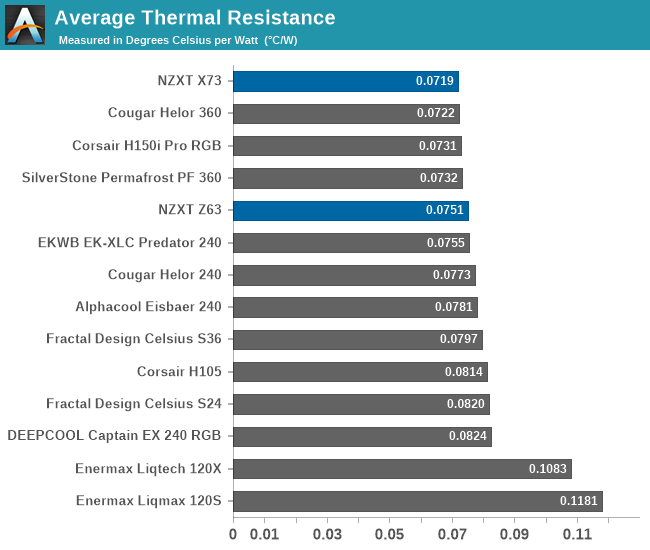
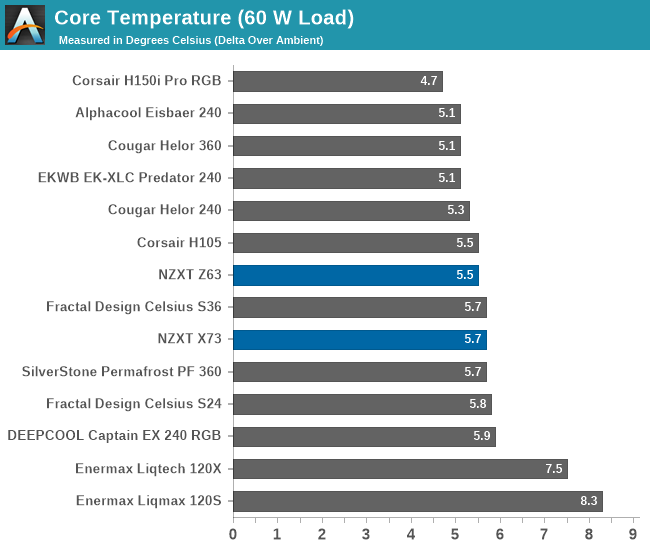
| Core Temperature, Constant Thermal Load (Max Fan Speed) |
The NZXT X73 stands out in our charts, as it manages to overtake every other similarly-sized AIO cooler that we have tested to this date. It has an average thermal resistance of 0.0719 °C/W, which is very good, but that comes with a sound pressure level of 42.9 dB(A), a figure that is definitely on the high side when compared to other, similar solutions. Although the X73 seems to be falling slightly behind when the thermal load is low, it is very efficient when having to cope with high loads, making it one of the best AIO coolers for handling large thermal loads.
Meanwhile the Z63, despite the use of 140 mm fans, falls behind in terms of cooling performance. With an average thermal resistance of 0.0751 °C/W, the Z63 performs well enough, but its thermal performance is fairly close to other coolers with smaller 240 mm radiators; so the Z63's extra size doesn't seem to be helping it much. Past this, like the X73, the Z63 does not stand out when the thermal load is low, but it is significantly more efficient when the thermal load is very high.
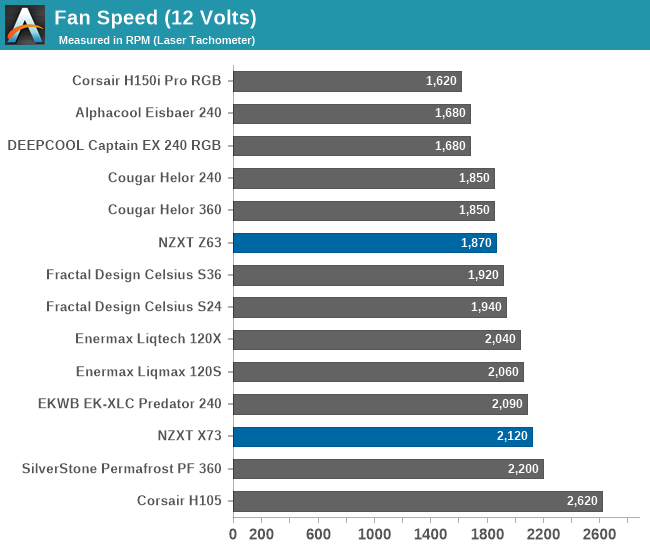
The Z63 does come with one upside, however: with a sound pressure level of 39.8 dB(A), noise levels are notably lower than those from the X73.
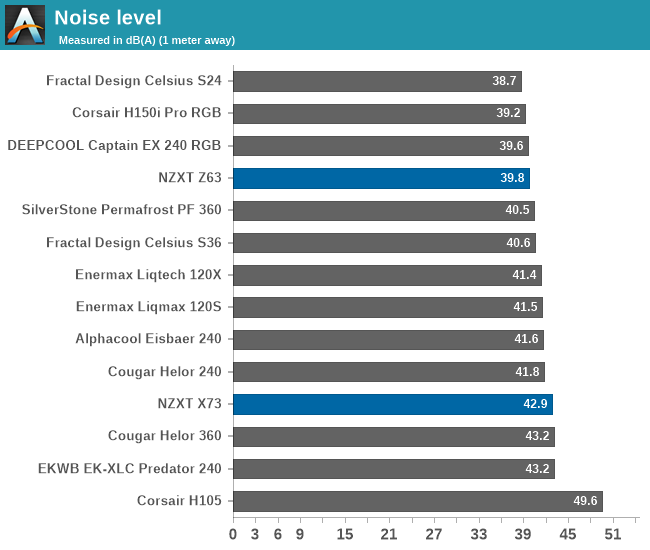
Testing Results, Low Fan Speed
Using a PWM voltage regulator, we reduced the speed of the fans manually down to half their rated speed. At this setting, the 120 mm fans of the X73 and the 140 mm fans of the Z63 rotate at 1240 RPM and 1050 RPM respectively. The pumps were also connected on the same power source, functioning properly at this low speed setting.
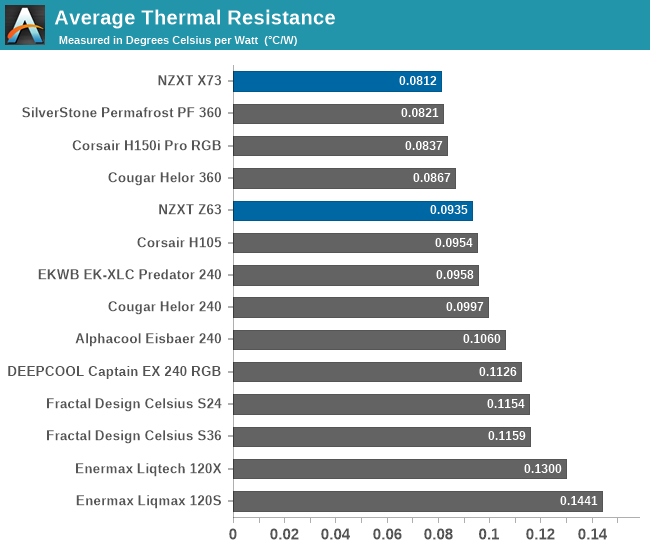
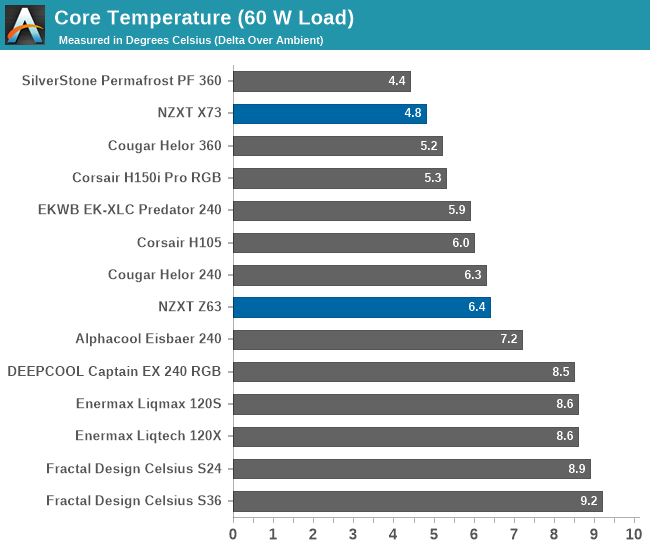
| Core Temperature, Constant Thermal Load (Low Fan Speed) |
NZXT’s X73 once again stands out with an average thermal resistance of 0.0812 °C/W, the best average figure that we have recorded from any AIO cooler to this date. The thermal resistance of the X73 is virtually stable regardless of the load with its pump and fans operating in this state, surpassing most other AIO coolers in any scenario.
However when we check our sound level meter, we measure a sound pressure of 37.4 dB(A), a relatively high figure compared to other coolers. That is mostly because of the high speed and high static pressure nature of the fans, which creates aerodynamic noise. That said, the cooler can certainly operate at lower noise levels if connected to a dynamic control system, such as any modern motherboard that would allow full control over the speed of its fans and pump, but at the obvious expense of thermal performance.
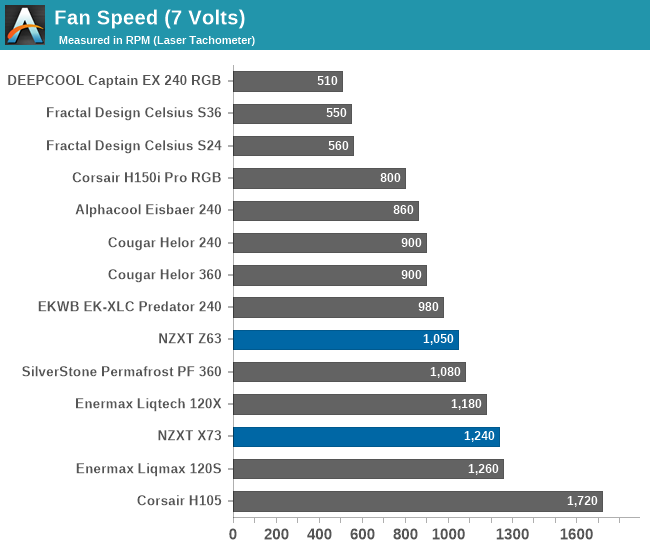
The NZXT Z63 also performs well in our low-speed testing. With an average thermal resistance of 0.0935 °C/W, the 280 mm cooler manages to get dangerously close to many larger AIO coolers, and even surpasses a few of them. Although the mediocre results we got from low load testing initially misguided us into believing that the Z63 will fall far behind the competition, it proved to be very efficient at handling heavy loads. Meanwhile the 35.1 dB(A) of noise coming from the cooler should be tolerable for the majority of home PC users.

Thermal Resistance VS Sound Pressure Level
During our thermal resistance vs. sound pressure level test, we maintain a steady 100W thermal load and assess the overall performance of the coolers by taking multiple temperature and sound pressure level readings within the operating range of the stock cooling fans. The result is a graph that depicts the absolute thermal resistance of the cooler in comparison to the noise generated. For both the sound pressure level and absolute thermal resistance readings, lower figures are better.
This graph reveals very interesting information. We can see that the NZXT X73 surpasses the absolute thermal resistance of all other 360 mm radiator coolers and also is quieter than Cougar’s Helor and the older Celsius S36. But it is slightly louder than the PF 360 at any given level of thermal performance.
More interesting, perhaps, is the NZXT Z63. It may trail the thermal resistance of the X73 by a small margin, but it manages the same level of thermal performance with significantly less noise. The thermal resistance to sound pressure level curve is steep and suggests that the Z63 can, at the expense of higher noise levels, even outperform the 360 mm coolers if paired with more powerful 140 mm fans.


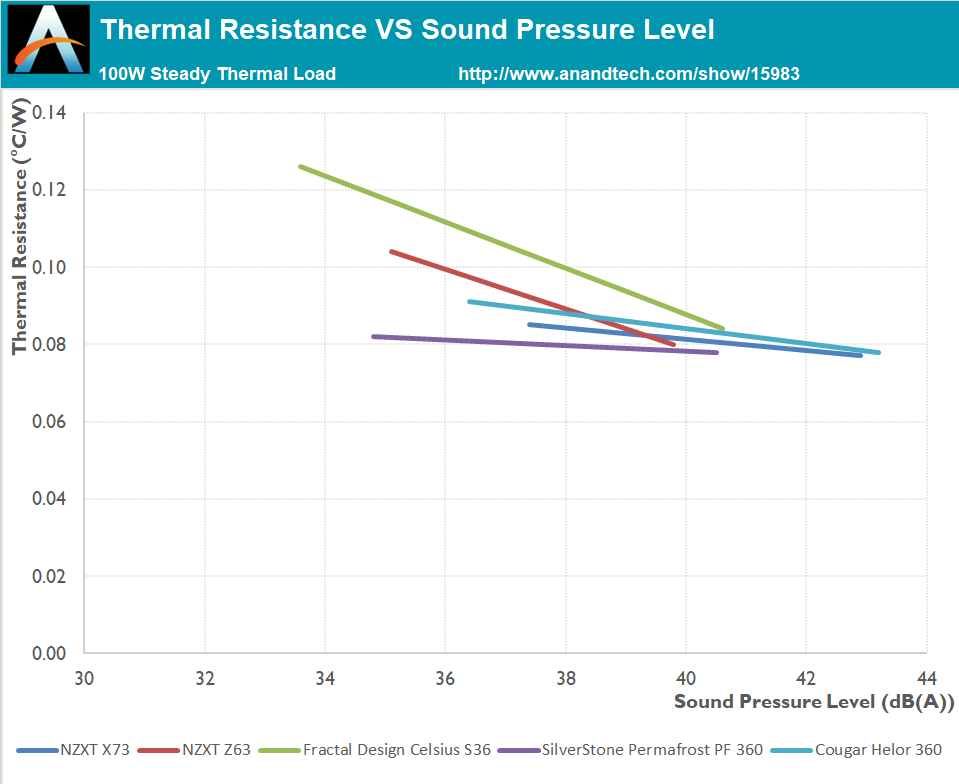








61 Comments
View All Comments
menorton - Wednesday, August 19, 2020 - link
What exactly is the cost of these coolers compared to others listed in the review? Seems common sense to include this, unless I missed the MSRP.Hyoyeon - Wednesday, August 19, 2020 - link
X53: $130X63: $150
X73: $180
The Z series is + $100
Cellar Door - Thursday, August 20, 2020 - link
Ridiculous prices - for what amounts to a cooler that has a service life of 5-7 years. Its NOT user serviceable and will go in a landfill since most people will just replace it when the pump goes.My Noctua nh-14D is on a 5th or 6th build and works like new - I have no intention of ever buying another cooler.
Destoya - Thursday, August 20, 2020 - link
E-waste concerns aside, at least NZXT's CLC warranty is category-leading at 6 years. The pump on my X61 died back in March after 5 years of service and they shipped me a new X62 within a couple days of them receiving the support ticket. My other interactions with their support service have been very positive as well, once for replacing a fan that had a bearing go bad and another for getting the AM4 bracket for the cooler.I don't necessarily like these CLCs having a finite service life but at the end of the day they do perform measurably better than even the best air coolers and that means a quieter, faster PC.
mervincm - Friday, August 21, 2020 - link
In the exact situation with my Noctua NH-D14. It is also why I just ordered an NH-D15 for a second system. My experience with liquid cooling was that it was more complex/ noise / cost / hassle / e-waste.godrilla - Friday, August 21, 2020 - link
Set it and forget it Noctua D15 all the way. Even fits in my H210 and a hybrid 2080ti.Revv233 - Tuesday, September 1, 2020 - link
Any large air cooler can cool just about any chip. I have a 14 & a 15 as well as some phanteks in various builds. Hell I still have a $30 big typhoon kicking around somewhere that im sure would do just fine. At some point AIO's became must have but I don't get it ESP when the noctua still outperforms 90% of them.shaolin95 - Saturday, March 20, 2021 - link
Lol because it doesn't outperform or match about of the recent AIOsNoctua fans live in denial lol
frbeckenbauer - Saturday, August 22, 2020 - link
basically, the 120mm version of this is a lot more expensive than other 360mm coolers, you pay for the screen on the pump-block-comboGuspaz - Wednesday, August 19, 2020 - link
Isn’t this just another rebadged (or rather slightly customized) Asetek cooler?